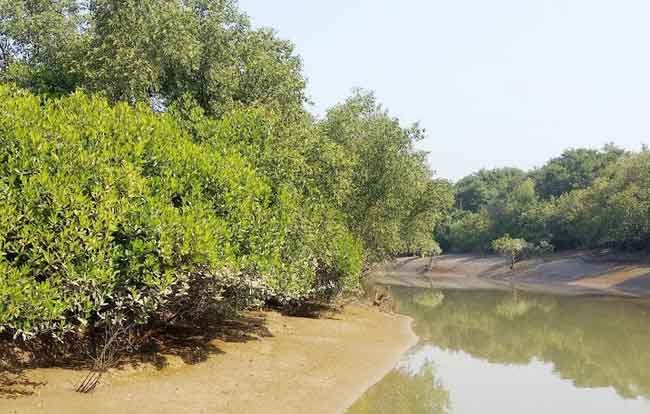The reduction in water flow will lead to drastic changes in the water regime of Bhittarkanika mangroves as there shall be acute shortage of fresh water.
Odisha Channel Bureau
Bhubaneswar: The world famous Bhittarkanika mangrove forests of Odisha are now under severe threat due to planned diversion of fresh water from the Brahmani river basin. Though Bhittarkanika is a notified Ramsar Convention wetland, the State government has ignored the need to conserve it for posterity, alleged Biswajit Mohanty, secretary of the Wildlife Society of Orissa.

In a statement issued on September 3, Mohanty said that no mangrove eco system can survive in the world without fresh water. Fresh water mixes with sea water near the lower end of Brahmani and Kharasrota rivers to produce brackish water ideal for mangroves.
Brackish water is also high in nutrients for a variety of life forms like crustacean, fish, aquatic flora and water birds. Bhittarkanika records seven species of kingfishers due to the salinity gradient of its water who would abandon the area if the water turns completely saline. Mangroves which grow in brackish water are very sensitive to changes in salinity.
The Talcher-Angul coal mines, steel and power plants as well as the Kalinga Nagar steel and power hub are drawing enormous quantities of fresh water from the Brahmani river. Once the Rengali Irrigation canals are completed more water shall be diverted leaving almost no fresh water for downstream areas. Abundant supplies of fresh water are needed by the Kalinga Nagar Industrial hub. Steel units like Jindal Stainless, Tata Steel, Mesco, Bhusan, NINL that are situated downstream of Samal Barrage with a total capacity of 25 million tonnes are drawing water from the Brahmani river, according to the statement.
Steel making requires enormous quantities of water and for every tonne of finished steel, 100,000 cubic metres of water is required. The total live storage capacity (LSC) of Rengali Reservoir is 4,400 million cubic metres (mcum). Rengali canals shall require 3,450 mcum. Large industrial users like NTPC, NALCO, Mahanadi Coalfields, JSPL shall draw 454 mcum from the Samal Barrage in Angul district. Additional 414 million cubic metres shall be drawn from Kharasrota (distributary of Brahmani river) at Jokadia barrage to meet water needs o the Kalinga Nagar industrial complex.
Thus against an available 4,400 million cum of fresh water stored by Rengali Reservoir 4,318 million cubic metres that is almost equal to the available water supply shall be withdrawn from the river. The govt claims that only 105 million litres shall be withdrawn for the mega drinking water project. Even this will affect the sensitive water balance, Mohanty pointed out.
The government should consider other sources of fresh water. Hadgarh Reservoir on the Salandi river or the newly built Kanpur barrage on the Baitarani river are potential sources to meet the requirements of Bhadrak district. The mega drinking water project on Kharasrota shall hasten the water shortage since there shall be hardly any water to spare once the Rengali canals are fully operational.
These rich mangrove forests spread over 195 sq.kms have a high level of bio diversity since 62 of the world’s 73 mangrove species are found here. They are also the habitat for more than 1,600 salt water crocodiles as well as breeding grounds for fish, crabs and shrimps.
Nutrients from this area are flushed out to the Gahirmatha Marine Sanctuary which attracts the world’s largest population of Olive Ridley sea turtles for congregation and nesting. Nearly half million turtles arrive here every winter. Without the mangroves, the Gahirmatha Marine Sanctuary will become a “marine desert” and lose its richness and diversity of marine life.
The reduction in water flow will lead to drastic changes in the water regime of Bhittarkanika mangroves as there shall be acute shortage of fresh water. Sunderbans mangrove forests was drastically affected after Farraka Barrage was commissioned since the famous Sundari trees disappeared soon after.
In a bad monsoon year, the situation will be catastrophic for the mangroves. The water availability at Jokadia is drastically reducing every year. It was only 98.56 cusecs in April, 2003 compared to 231.66 cusecs in April, 1999 – a decrease of nearly 58% in just four years!
Lack of normal flow of fresh water will increase saline ingression upstream. This shall affect the local flora and fauna as well as the livelihoods of farmers and fishermen dependent upon Brahmani and Kharasrota waters. Similarly, commercially important species like fresh water shrimp, mullets, mud crabs and bhekti are expected to disappear, leading to decline in incomes of thousands of fishermen of Kendrapada district.
There shall be a quantum jump in man–crocodile conflict since the estuarine crocodiles shall leave the core sanctuary area and migrate upstream once salinity increases. Crocodiles may move up the river Dhenkanal district. Many local people are likely to be attacked by the salt water crocodiles while bathing in the Brahmani and Kharasrota rivers.
The state government has not yet revealed how it plans to ensure adequate flow of fresh water in the Kharasrota and Brahmani rivers that feed Bhittarkanika once the Rengali canals start drawing water.
“The water supply is not limitless and the priority should be for drinking and irrigation. The “ecological flow” of fresh water to ensure the health of mangroves of Bhittarkanika should also be maintained,” said Mohanty.
















